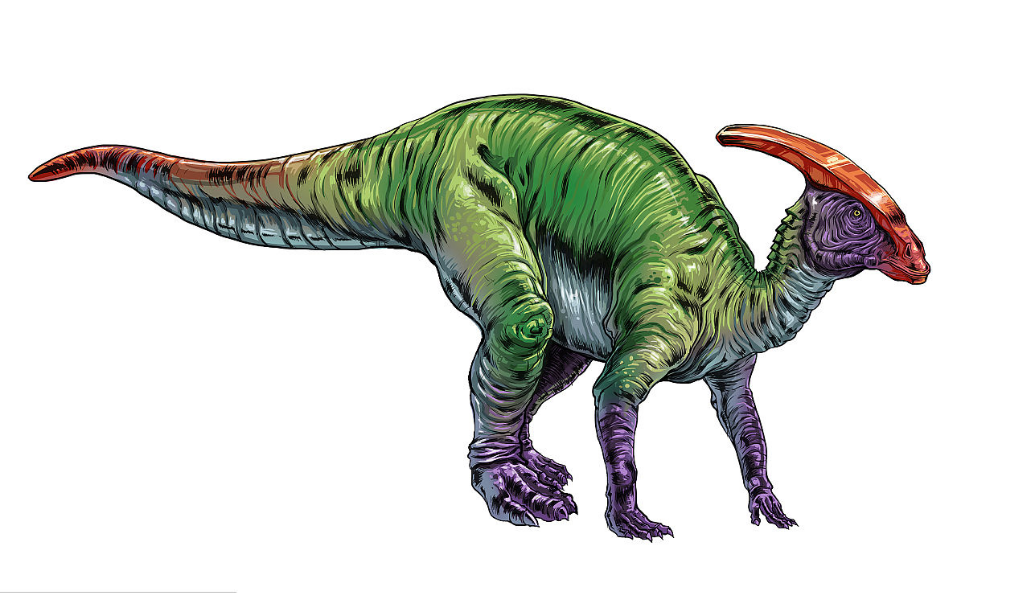Dinosaur Knowledge Tips Hadrosaurid
Release time:2018/3/12 11:07:00

Hadrosaurids (Greek: ἁδρός, hadrós, "stout, thick"), or duck-billed dinosaurs, are members of the ornithischian family Hadrosauridae. This group is also known as the duck-billed dinosaurs, for the flat, duck-bill appearance of the bones in their snouts. The family, which includes ornithopods such as Edmontosaurus and Parasaurolophus, was a common herbivore in the Upper Cretaceous Period of what is now Asia, Europe, Antarctica, South America, and North America. Hadrosaurids are descendants of the Upper Jurassic/Lower Cretaceous iguanodontian dinosaurs and had a similar body layout. Like the rest of the ornithischians, these animals had a predentary bone and a pubic bone which was positioned backwards in the pelvis. Hadrosaurids are divided into two principal subfamilies: the lambeosaurines (Lambeosaurinae), which had hollow cranial crests or tubes, and the saurolophines, identified as hadrosaurines in most pre-2010 works (Saurolophinae or Hadrosaurinae), which lacked hollow cranial crests (solid crests were present in some forms). Saurolophines tended to be bulkier than lambeosaurines. Lambeosaurines are divided into aralosaurines, lambeosaurines, parasaurolophines, and tsintaosaurines, while saurolophines include saurolophus, brachylophosaurines, and kritosaurines.
Hadrosaurids were facultative bipeds, with the young of some species walking mostly on two legs and the adults walking mostly on four. Their jaws were designed for grinding plants, with multiple rows of teeth replacing each other as the teeth wore down.

The family Hadrosauridae was first used by Edward Drinker Cope in 1869. Since its creation, a major division has been recognized in the group between the (generally crested) subfamily Lambeosaurinae and (generally crestless) subfamily Saurolophinae (or Hadrosaurinae). Phylogenetic analysis has increased the resolution of hadrosaurid relationships considerably (see Phylogeny below), leading to the widespread usage of tribes (a taxonomic unit below subfamily) to describe the finer relationships within each group of hadrosaurids. Recent phylogenies also support the monophyly of both the Saurolophinae and the Lambeosaurinae. However, some hadrosaurid tribes commonly recognized in online sources have not yet been formally defined or seen wide use in the literature. Several were briefly mentioned under informal names, but not named as such, in the first edition of The Dinosauria. In this 1990 reference, "gryposaurs" included Aralosaurus, Gryposaurus, Hadrosaurus, and Kritosaurus; "brachylophosaurs" included Brachylophosaurus and Maiasaura; "saurolophs" included Lophorhothon, Prosaurolophus, and Saurolophus; and "edmontosaurs" included Edmontosaurus, and Shantungosaurus.
Lambeosaurines have also been traditionally split into Parasaurolophini and Lambeosaurini. These terms entered the formal literature in Evans and Reisz's 2007 redescription of Lambeosaurus magnicristatus. Lambeosaurini is defined as all taxa more closely related Lambeosaurus lambei than to Parasaurolophus walkeri, and Parasaurolophini as all those taxa closer to P. walkeri than to L. lambei. In recent years Tsintaosaurini (Tsintaosaurus + Pararhabdodon) and Aralosaurini (Aralosaurus + Canardia) have also emerged.
The use of the term Hadrosaurinae was questioned in a comprehensive study of hadrosaurid relationships by Albert Prieto-Márquez in 2010. Prieto-Márquez noted that, though the name Hadrosaurinae had been used for the clade of mostly crestless hadrosaurids by nearly all previous studies, its type species, Hadrosaurus foulkii, has almost always been excluded from the clade that bears its name, in violation of the rules for naming animals set out by the ICZN. Prieto-Márquez defined Hadrosaurinae as just the lineage containing H. foulkii, and used the name Saurolophinae instead for the traditional grouping.

While studying the chewing methods of hadrosaurids in 2009, the paleontologists Vincent Williams, Paul Barrett, and Mark Purnell found that hadrosaurs likely grazed on horsetails and vegetation close to the ground, rather than browsing higher-growing leaves and twigs. This conclusion was based on the evenness of scratches on hadrosaur teeth, which suggested the hadrosaur used the same series of jaw motions over and over again. As a result, the study determined that the hadrosaur diet was probably made of leaves and lacked the bulkier items, such as twigs or stems, that might have required a different chewing method and created different wear patterns. However, Purnell said these conclusions were less secure than the more conclusive evidence regarding the motion of teeth while chewing.
The hypothesis that hadrosaurs were likely grazers rather than browsers appears to contradict previous findings from preserved stomach contents found in the fossilized guts in previous hadrosaur studies. The most recent such finding before the publication of the Purnell study was conducted in 2008, when a team led by University of Colorado at Boulder graduate student Justin S. Tweet found a homogeneous accumulation of millimeter-scale leaf fragments in the gut region of a well-preserved partially grown Brachylophosaurus. As a result of that finding, Tweet concluded in September 2008 that the animal was likely a browser, not a grazer. In response to such findings, Purnell said that preserved stomach contents are questionable because they do not necessarily represent the usual diet of the animal. The issue remains a subject of debate.
Mallon et al. (2013) examined herbivore coexistence on the island continent of Laramidia, during the Late Cretaceous. It was concluded that hadrosaurids could reach low-growing trees and shrubs that were out of the reach of ceratopsids, ankylosaurs, and other small herbivores. Hadrosaurids were capable of feeding up to 2 m when standing quadrupedally, and up to 5 m bipedally.
Coprolites (fossilized droppings) of some Late Cretaceous hadrosaurs show that the animals sometimes deliberately ate rotting wood. Wood itself is not nutritious, but decomposing wood would have contained fungi, decomposed wood material and detritus-eating invertebrates, all of which would have been nutritious. Examination of hadrosaur coprolites from the Grand Staircase-Escalante indicates that shellfish such as crustaceans were also an important component of the hadrosaur diet.
from Wikipedia